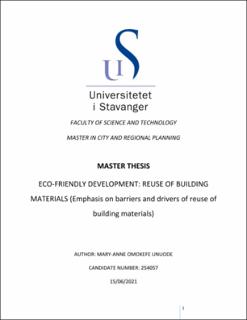| dc.description.abstract | The building and construction sector has emerged with so many concepts having sustainability as the baseline in order to reduce the amount of carbon emissions the sector produces. The building and construction sector is a major contributor to socio-economic developments for countries worldwide, but the sector’s growth takes up 30% of raw materials harvested annually is consumed, 25% of water and 12% of land is also consumed globally and it generates over 25% of solid waste. Additionally, this sector records about 40% of greenhouse gas emissions, this mainly consists of energy use during buildings’ life cycle. The sector would definitely benefit from finding new ways to boost its sustainability so that its growth and progress does not signal doom for future generations. One of such ways that will be examined in this study is the reuse of building materials. In Europe alone building and construction waste makes up 1/3 of all waste generated. Reuse of building materials is possible because there are some materials whose resource value is high which means they can be reused many times before having to be destroyed or condemned. It is therefore important to explore the reuse of building materials because not only will they be reducing the amount of waste being dumped in landfills but they will be replacing primary materials and reducing natural resource depletion.
The paper aims to understand the potential for reuse of building materials by examining the barriers and drivers that affect reuse of building materials. In doing so, challenges being experienced by individuals and professionals in the built environment are explored such as project costs, policy control and the likes.
The research question shaped up the objective and was a guide that helped formulate an answer for the research question; which were to understand the potential barriers and drivers affecting actors and users of reuse of building materials while also understanding the behavior practices that affect reuse. Qualitative and quantitative data gathered from interviews and questionnaires to compare previous literature is utilized in order to understand if there is any changes since reuse started gathering more attention. The research aimed to look at the picture of the built environment in general while using Norway as a case study.
The findings from the data gathered while compared to previous literature from not earlier than 2008, show that the barriers to reuse are still being experienced as much as they were more than 10 years ago. This suggests that the concept of reuse while growing is still developmental, there is still a long way to come from there. Drivers such as governmental incentives and training of built environment professionals is important for the growth of the reuse potential. | |
